Open roundabout
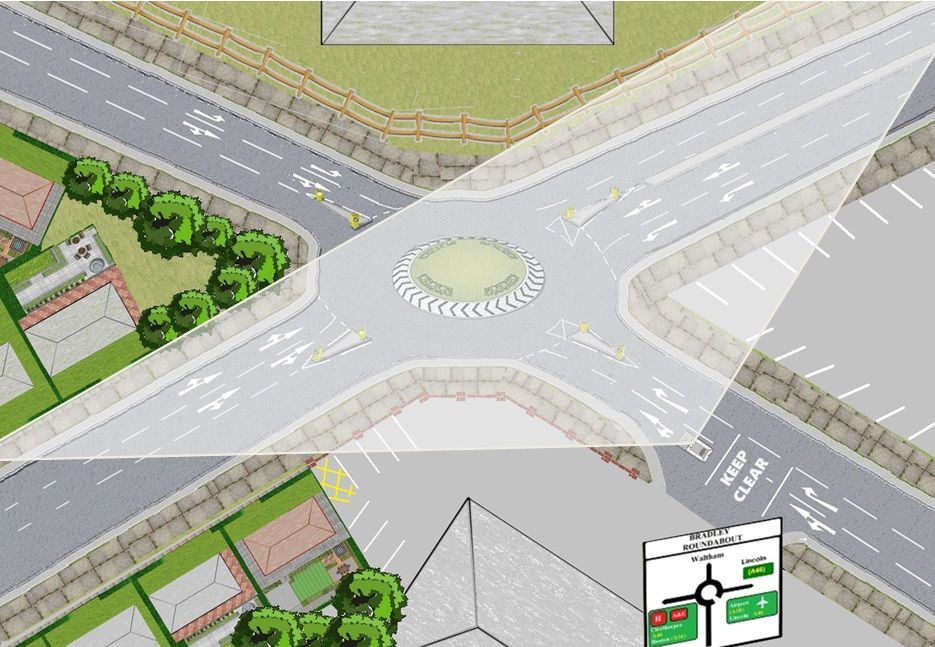
Closed roundabout
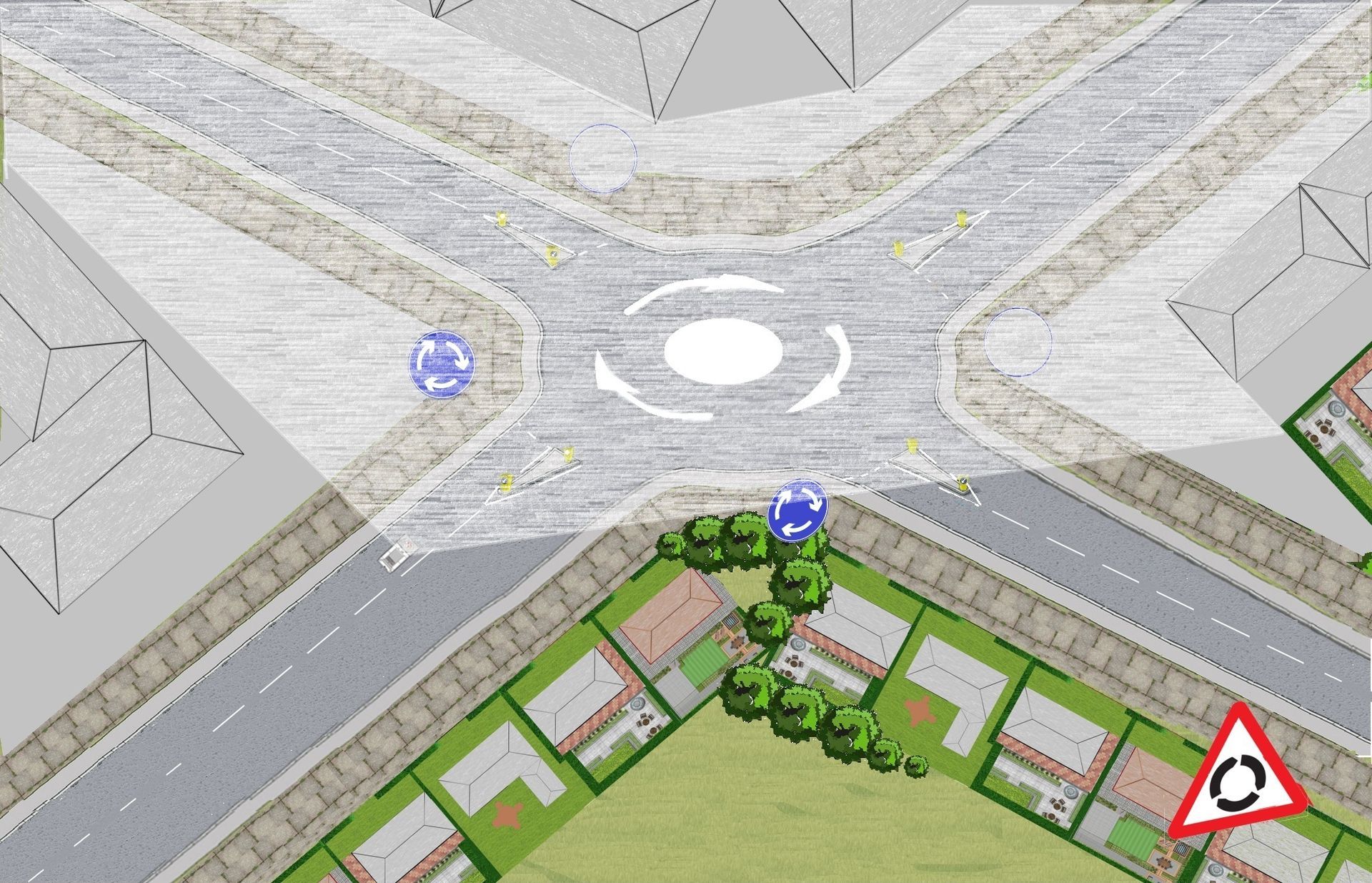
Giving way to your immediate right
On a previous roundabout brief it discussed three different zones (red) zone 1, (amber) zone 2 and (green) zone 3). Each zone is ether two white hazard warning lines or two average car lengths.
In the below diagram I've highlighted area's, as you approach a roundabout and the vehicle that is on the right or even ahead is further back from you from the roundabout it will probably safe to continue.
Approaching 6 lines away (Green zone)
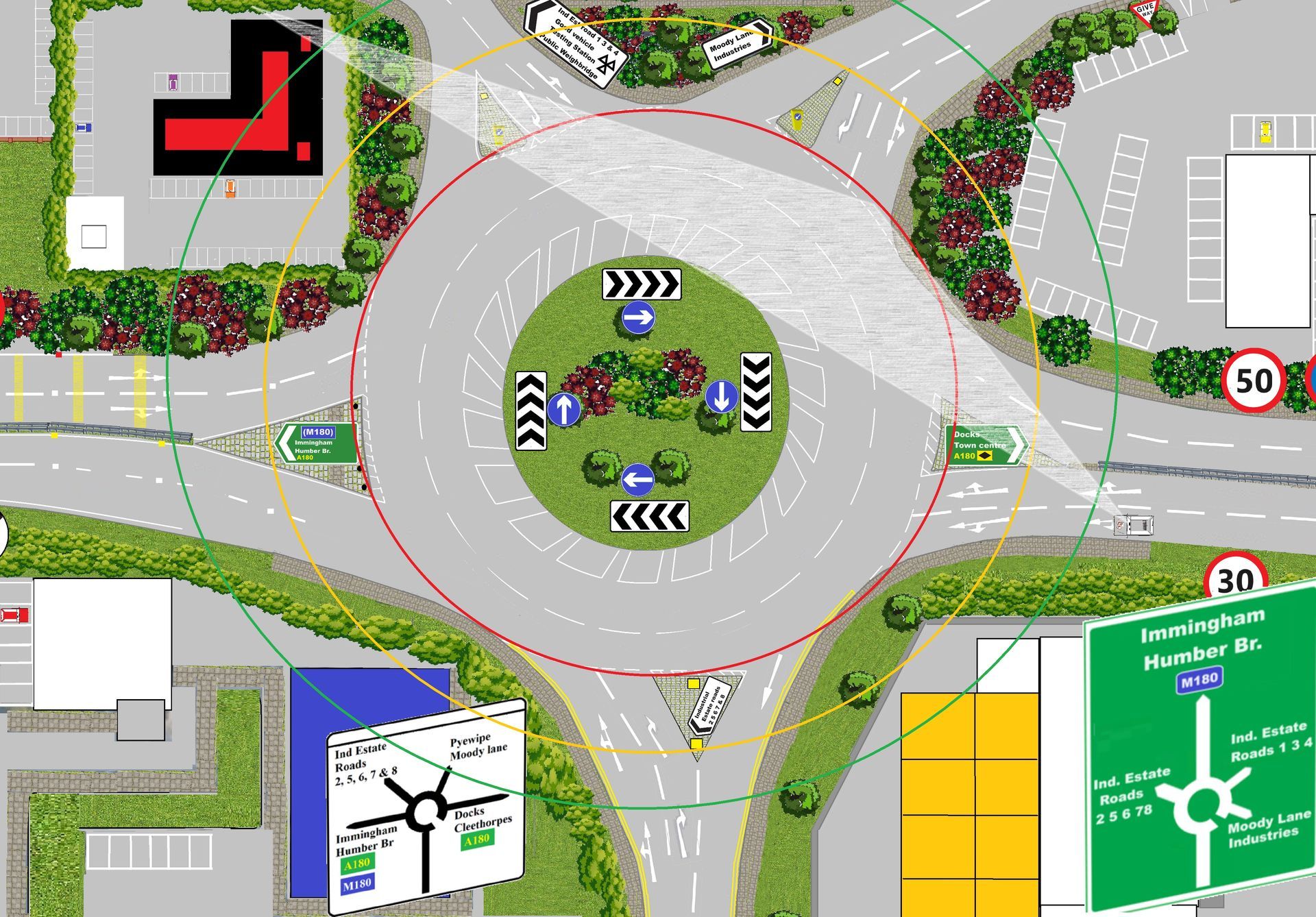
Approaching 4 lines away
(Amber zone)
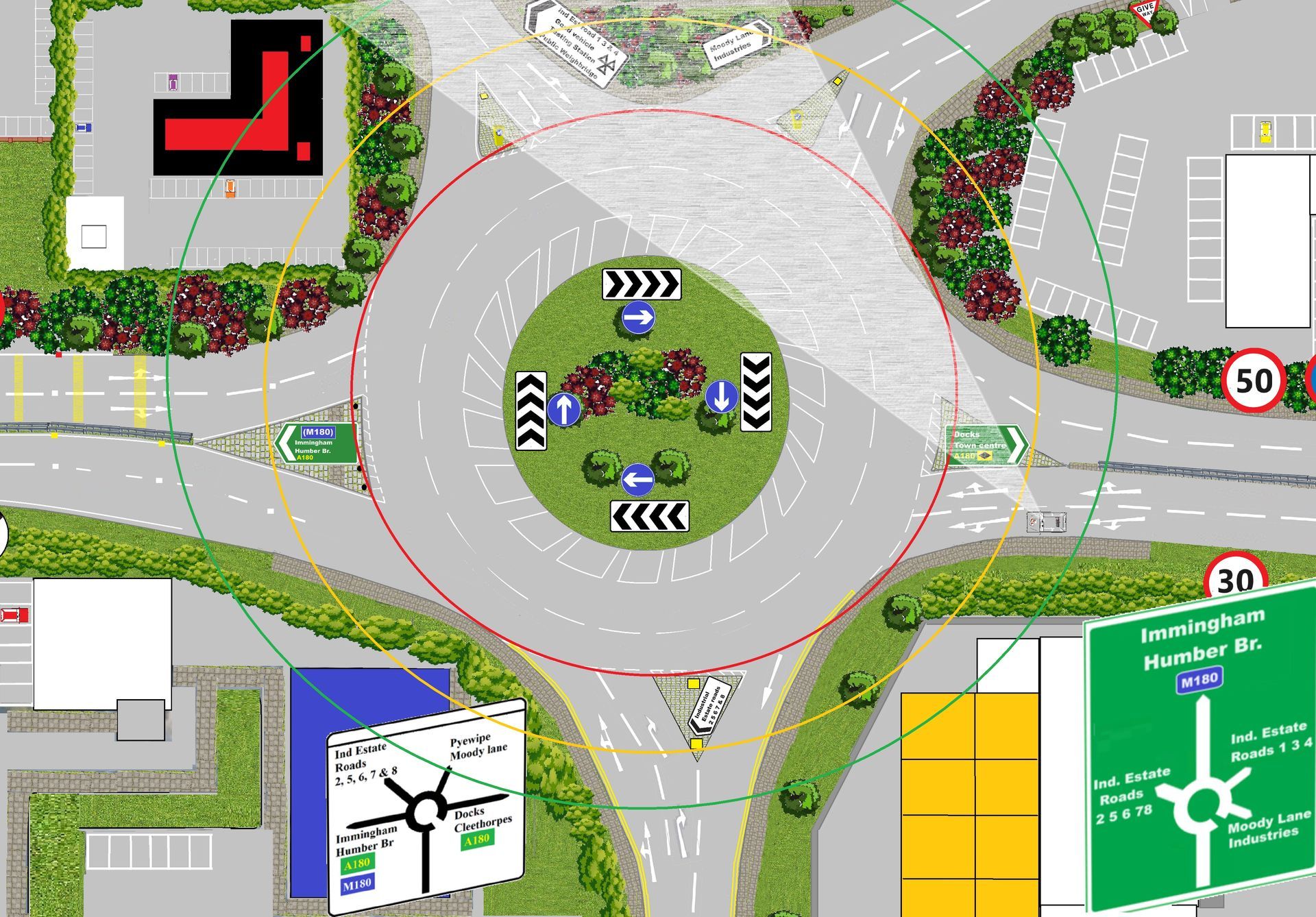
Approaching 0/2 lines away
(Red zone)
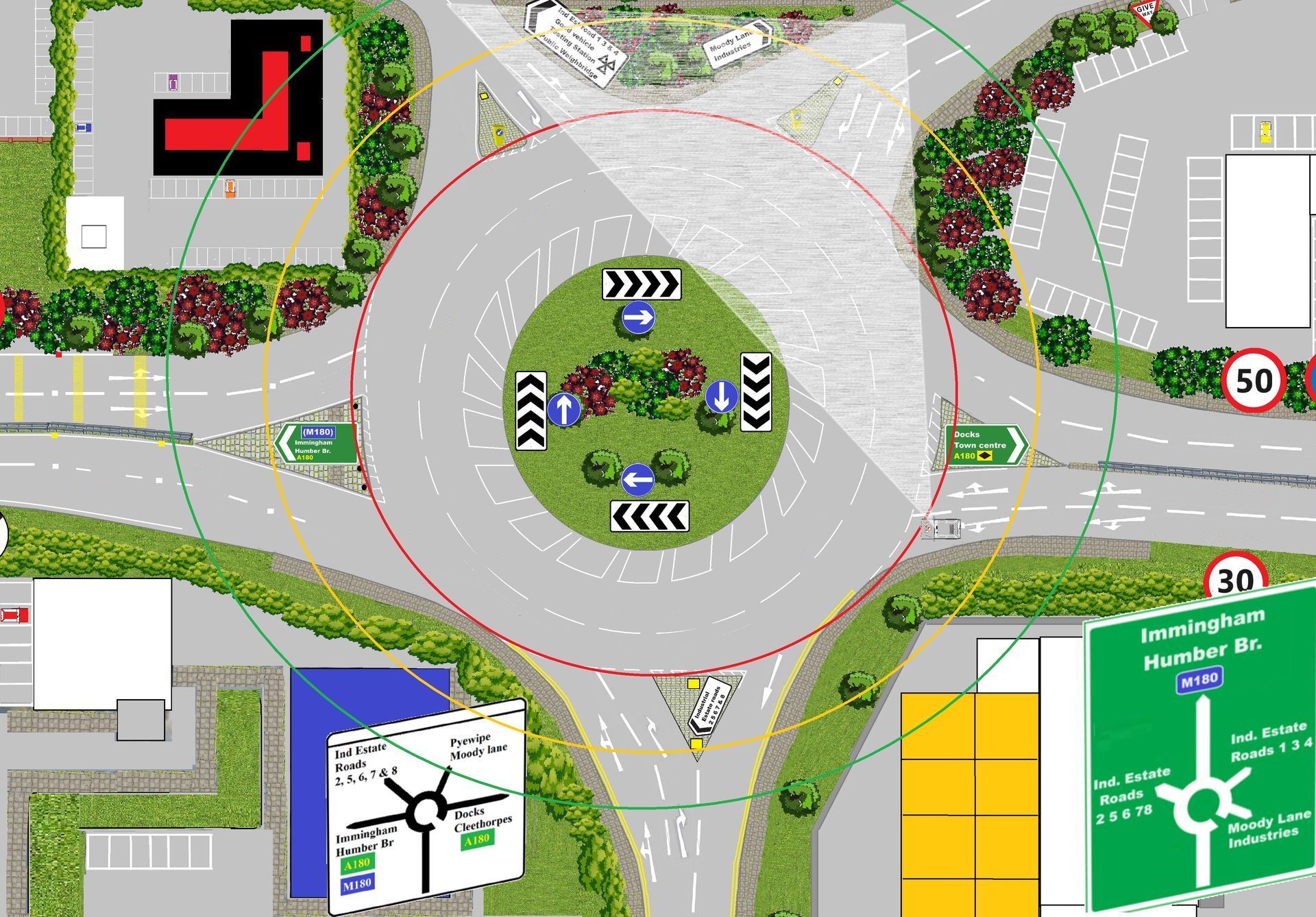
Forward planning
With the correct forward planning and the appropriate speed you will meet the requirements that meets the driving test criteria on the approach to roundabouts.
Below is the DL25 on roundabouts and the main faults.
You were marked on:
- approach speed - your ability to approach junctions at an appropriate speed
- observation - your effective observation and judgement of your surroundings
- turning right - your position when turning right
- turning left - your position when turning left
- cutting corners - your ability to avoid cutting corners when turning
You needed to show you can drive through junctions safely. You should have observed your surroundings, made your intentions clear, followed road signs and signals, and properly controlled the car.
Examples of faults
Some of the most common faults for this area include:
- incorrectly judging the speed of an oncoming vehicle, forcing it to slow down when emerging from a junction
- not checking for other road users when emerging from a slip road, onto a dual carriageway
- being positioned too far to the left when turning right onto a minor road, holding up vehicles behind you
- approaching a junction too fast, making it difficult to make observations
Your examiner may have explained the specific details of any faults you made.
How you can improve in this area
If you made faults in this area during your test, or if you want to improve in this area, you should:
check rules 170 to 190 of The Highway Code
read section 8 of ‘The Official DVSA Guide to Driving: the Essential Skills’ (2022 edition)
If you need to rebook the test, spend time practising and improving this skill with your driving instructor or supervising driver. You could work on:
using the mirrors - signal - manoeuvre (MSM) routine
using the position - speed - look (PSL) routine to improve your manoeuvres
approaching and emerging at a variety of different junctions
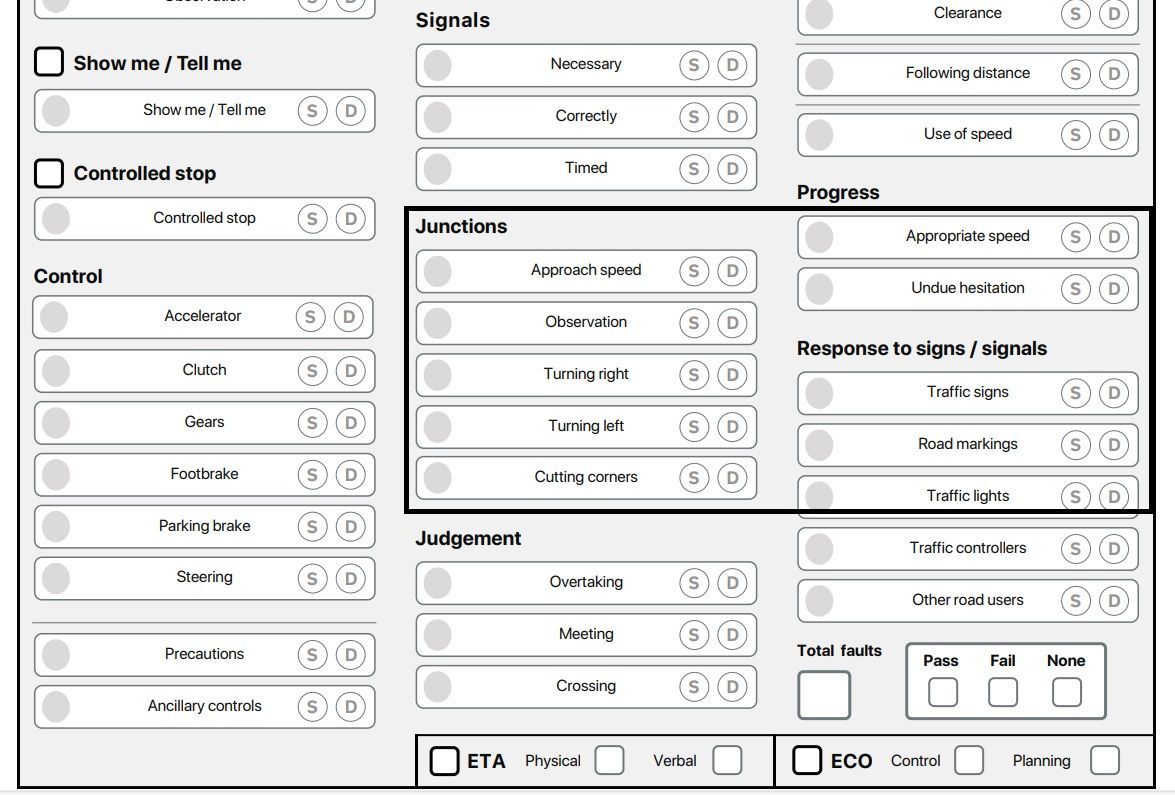
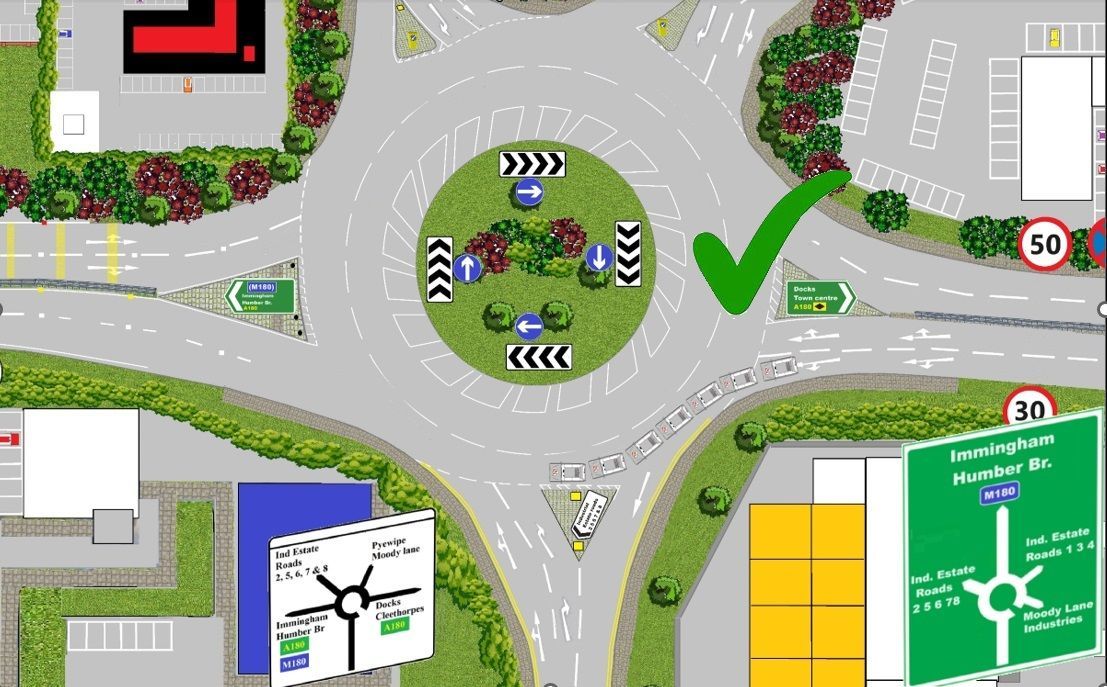
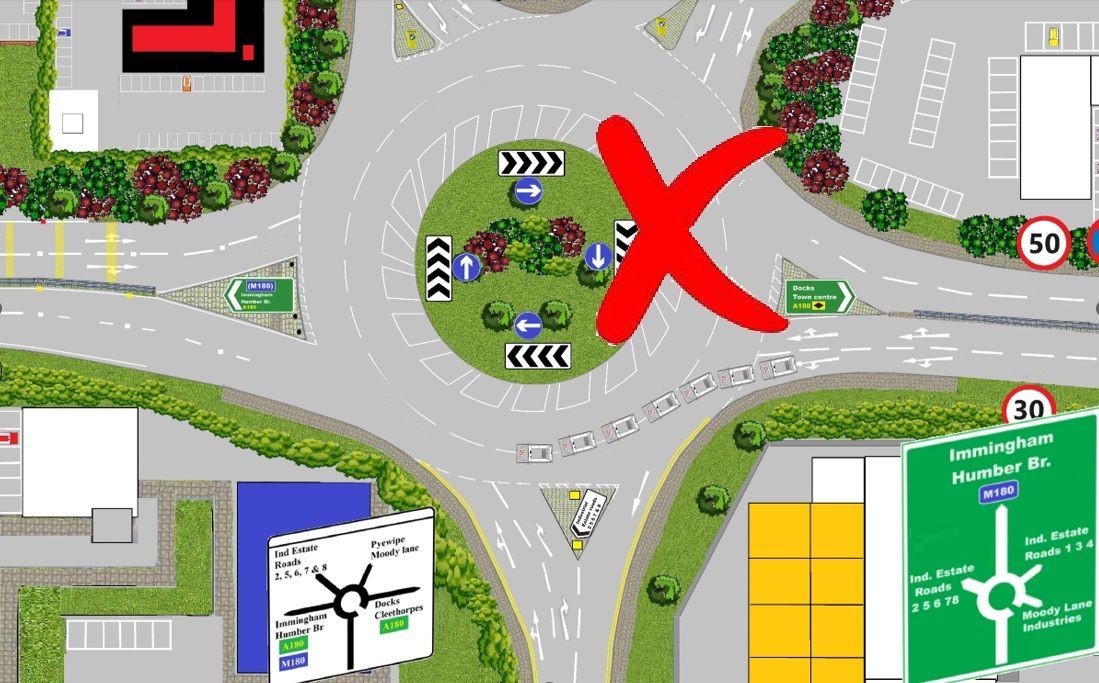
Below is more information on lane positioning on the DL25 marking sheet.
You were marked on:
- normal driving - your position of the car when driving such as not driving too close to the pavement or lines
- lane discipline - your ability to maintain your position within the lane
You needed to show you can keep your car correctly positioned on the road, staying within the correct lane, without driving too close to the lines.
Examples of faults
Some of the most common faults for this area include:
- driving too close to the pavement, putting pedestrians at risk
- driving too close to the centre of the road, putting other road users at risk
- driving for too long in the right hand lane of a dual carriageway, for no reason
- straddling lanes causing issues for other road users
Your examiner may have explained the specific details of any faults you made.
How you can improve in this area
If you made faults in this area during your test, or if you want to improve in this area, you should:
- check rules 135 and 137 of the Highway Code
- read pages 158 to 161 of ‘The Official DVSA Guide to Driving: the Essential Skills’ (2022 edition)
If you need to rebook the test, spend time practising this skill with your driving instructor or supervising driver. You could work on:
- identifying lane markings on the road
- changing lanes using mirrors - signal - manoeuvre (MSM)
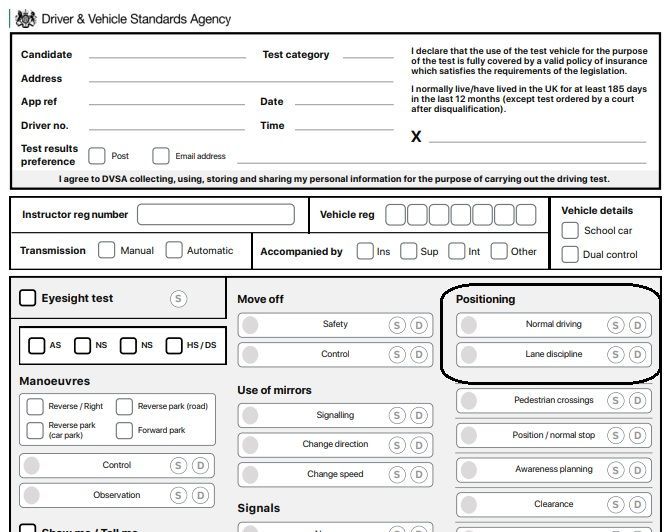
Colour of signs
Dual carriageways, roundabout and traffic light signs represent your location
- White is non primary
- Green is primary
- Blue
is motorway
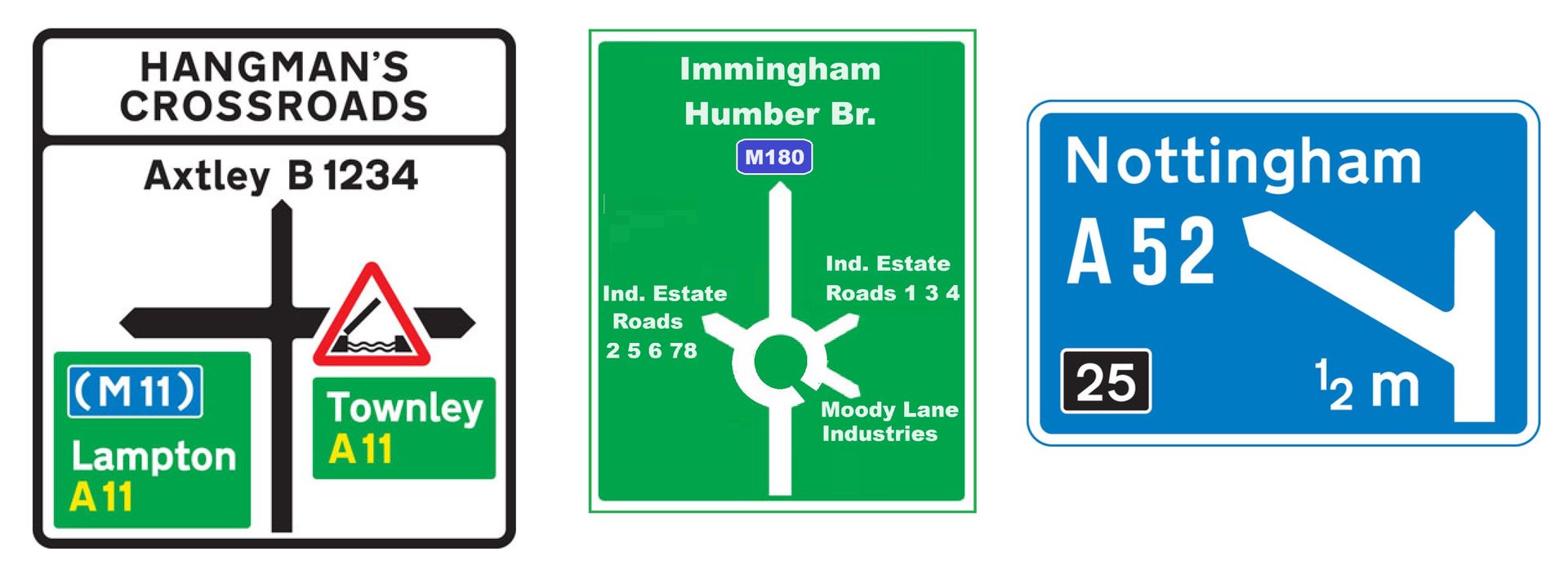
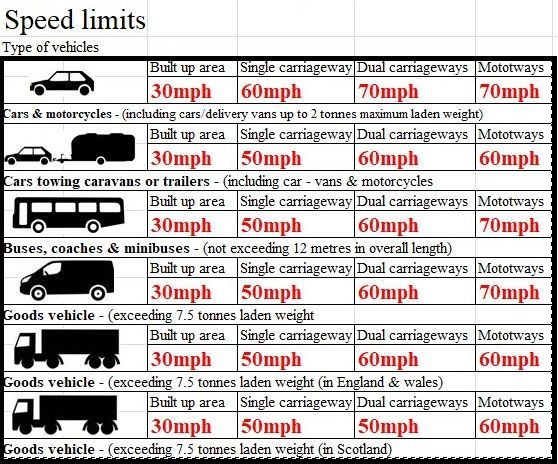
Information on a roundabout sign
Always remember you always approach from the 6 o'clock position.
As you can see:-
- 8 o'clock is sign posted West Marsh Industrial Estate.
- 10 o'clock is sign posted Birchin Way Industrial Estate.
- 12 o'clock is sign posted Immingham, Humber Bridge M180 & A180, but there is a difference it the direction is to the Motorway the back ground is in blue, this is informing you are going to a direction of a primary route.
- 2 o'clock it’s showing the directions for Commercial Dock West & Moody Lane Industries.
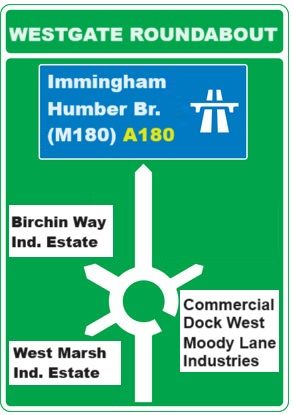
Observations on the approach
Unfortunately some drivers approach roundabouts as though they were approaching a give-way or stop line and only take observations at the last minute. Consequently vehicles behind may end up running into the back of them as they wouldn’t expect them to stop if the way was clear.
Therefore don’t make this mistake and do not assume that the vehicle in front will proceed even if the way is clear.
Tyre's and tarmac.
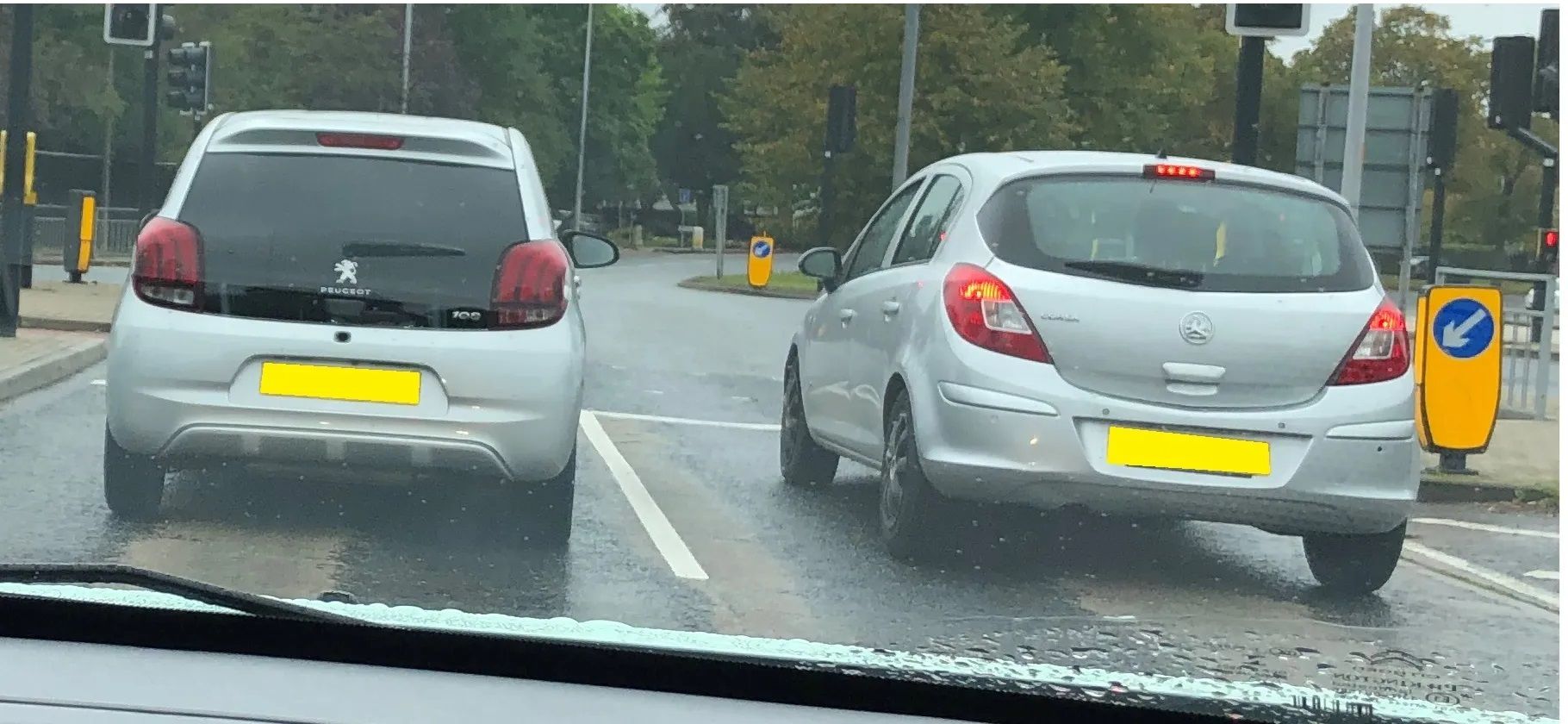

Turning right onto a dual carriageway
Throughout the 20+ years of teaching ensuring leaving in the correct lane has always been an issue when leaving a roundabout and joining a dual carriageway or motorway as it a scary process turning right at a roundabout and swapping lanes from lane 1 to lane 2. As a rule of thumb a LEARNER driver needs to have the confident to leaves to the left lane.
Why? The left lane is classed as the slower lane, an example if you was entering a dual carriageway and the road speed was changing from 30MPH to 60 or 70MPH and you have gone in to the right lane (lane 2) on the dual carriageway and have not not build your speed up to the road speed and vehicle behind you was approaching you faster than you are travelling and decides to undertake you.
This becomes a driver error on both part, A it is an illegal in this situation to undertake and B it is classed on a driving test a lane position error (you would also fail your practical test). Yes you are both at fault but the root cause of the error is that you are in the wrong lane holding up traffic and the inpatient driver that is aiming to undertake you should just wait behind you until you have fixed the lane position error.

Strategy
Remember to always indicate correctly to keep the flow of traffic going on and off a roundabout. A late signal will mislead traffic wanting to enter the roundabout.
On this section of the lesson brief we are going to breaks down leaving from Estate road 1 (the Grimsby test centre roundabout) and walk you though how to incorporate the hazard routine correctly on each direction.
Lets look at the use of the M.S.M routine from leaving the Grimsby test centre:-
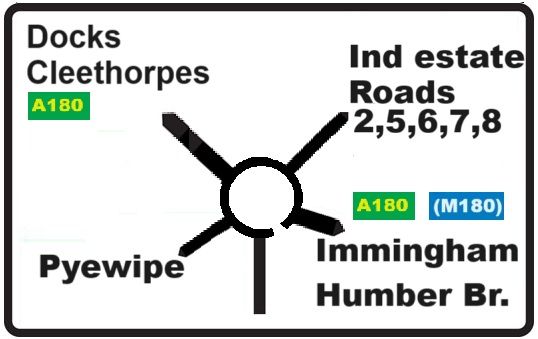
We are coming from Estate road 1 and explain how to work the the hazard and L.A.DA routines going to each exit. As already explained treat the roundabout like a clock face. Our exit is at 6 o'clock, the pyewipe is at 7 o'clock, A180/Cleethorpes is at 10 o'clock, Ind estate 2, 5,6,7 & 8 is at 2 o'clock and lastly the M180/Immingham and Humber bridge is at 4 o'clock. We say unless road marking or road signs dictate other wise any exit that is before 12 o'clock you will need the left lane and any thing past 12 o'clock you will need the outside lane.
The Yellow vehicle is taking the 1st exit so they start the M.S.M routine at the roundabout sign:-
At the roundabout sign
- Mirrors left & Signal left (at the roundabout sign) & keep left lane Position
2/4 lines from the give-way line
- Speed to 10/12 mph and 2nd Gear
L.A.D.A
- proceed when safe
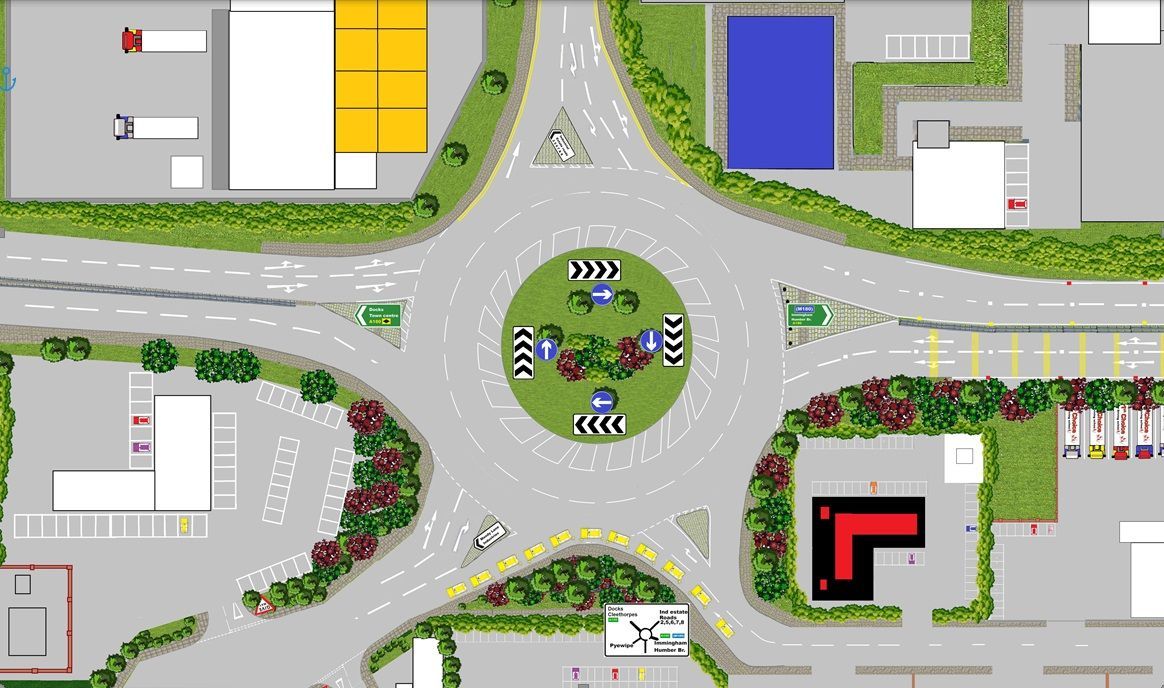
The Grey learner vehicle is taking the 2nd exit sign posted A180 & Docks. Start part of the M & S routine at the roundabout sign then at the island of the 1st exit (Moody lane) M.S.P.S.G:-
At the roundabout sign:-
- Mirrors at the roundabout sign & keep left lane Position
2/4 lines from the give-way line
- Speed to 10/12 mph & Gear down to 2nd
L.A.D.A
- proceed when safe
As you are passing the 1st exit
- Mirrors left
- Signal left & leave the roundabout
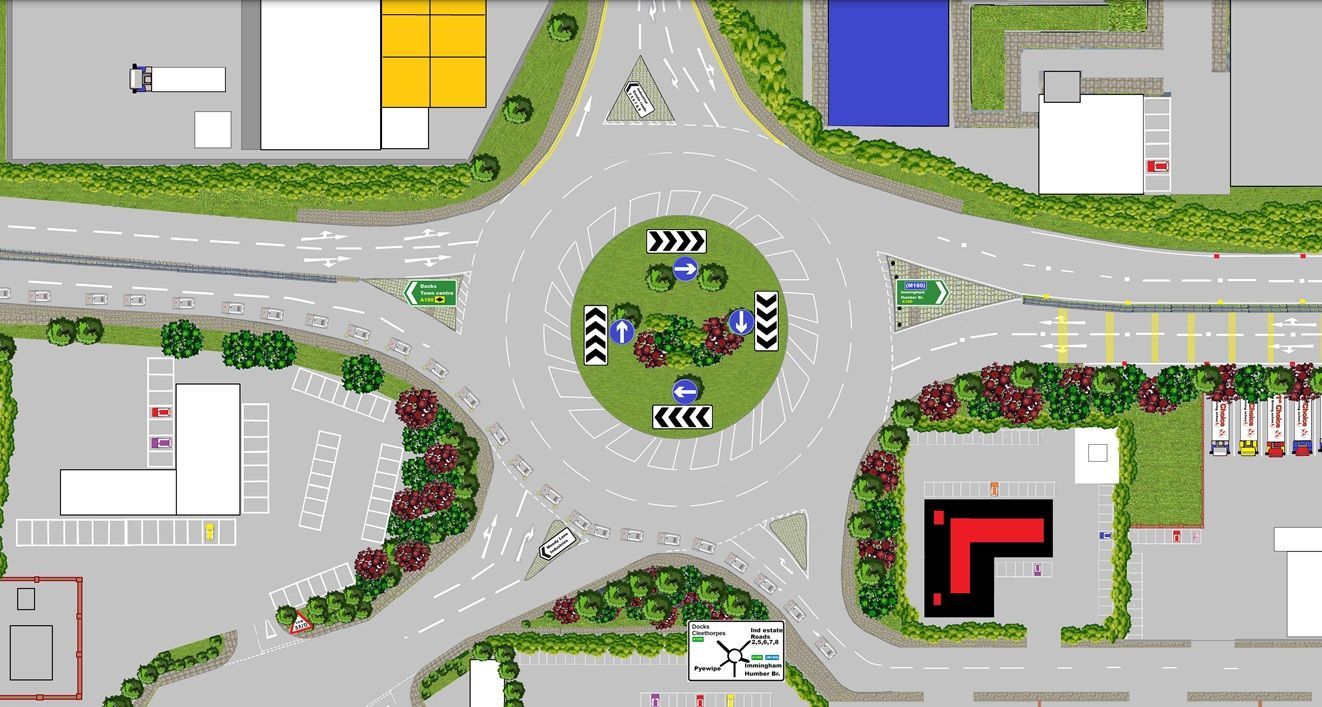
The Pink vehicle is taking the 3rd exit sign posted Est road 2,3,4,5. Start part of the M & S routine at the roundabout sign then at the island of the 2st exit (A180/Docks) M.S.P.S.G:-
At the roundabout sign:-
- Mirrors, Signal & Position right lane at
the roundabout sign
2/4 lines from the give-way line
- Speed to 10/12 mph & 2nd Gear
L.A.D.A
- proceed when safe
As you are passing the 2nd exit sign posted A180 docks
- Mirrors &
Signal left to leave the roundabout, Changing
position from lane 2 to lane 1

The
Red vehicle is taking the 4th exit sign posted M180/Immingham & Humber bridge. Start part of the M & S routine at the roundabout sign then at the island of the 3rd exit (A180/Docks) M.S.P.S.G to leave:-
At the roundabout sign:-
- Mirrors, Signal & Position right lane at
the roundabout sign
2/4 lines from the give-way line
- Speed to 10/12 mph & 2nd Gear
L.A.D.A
- proceed when safe
As you are passing the 3rd exit sign posted Est 2,3,4,5,6,7
- Mirrors &
Signal left to leave the roundabout, Changing
position from lane 2 to lane 1 & follow the sign for M180
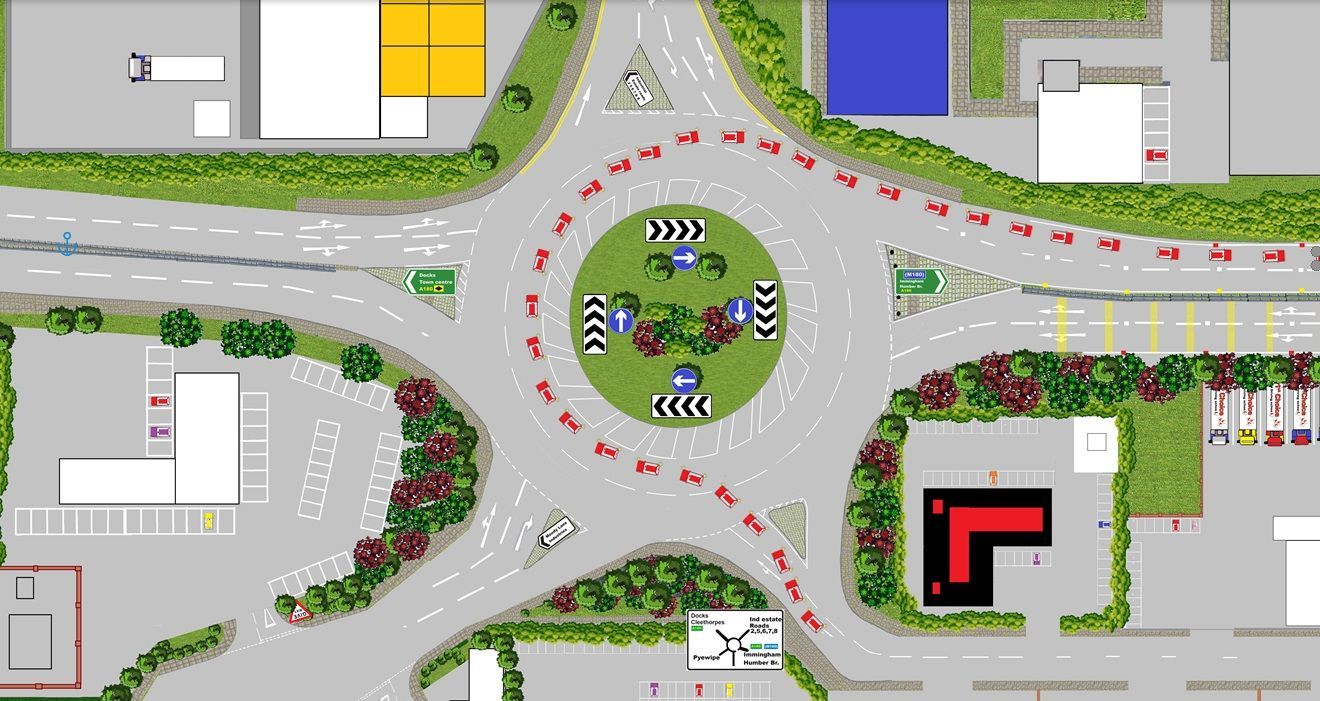
As you are learning its vital to leave to the left (slow) lane unless it is unsafe to do so. If you leave to the right lane (fast lane) and then you get undertaken as your going to slow in the fast lane its classed as dangerous so always aim for the left to leave (learner leaves to the left).
Agree your next lesson
learning techniques and strategies
Practice achieving and improving the timing of the M.S.P.S.G & L.A.D.A routine's at basic T junctions while improving your awareness and planning with the two second gap, the holding back position, overtaking, adequate clearance when overtaking stationary & slow moving vehicles.
Once you have practiced a few situations a few times your instructor will reduce his/her support transferring his responsibility over to you (that's if you agree with this).
Lesson Planning
- Agree learning goals and needs of todays lesson
- Agree appropriate lesson structure (full, partially or independent level of instruction)
- Practice in a suitable training area
Agreed if needed to adapt the lesson plan to help the pupil work towards their new learning goals if any verbal or physical intervention was made by the instructor
Risk Management
Fully understood how the responsibility for risk of the lesson would be shared on the lesson plan between instructor and student.
- Directional instructions will be given in ADI format (Alert, direction and identify manor) given to the pupil clear and given in good time
- Agree if the students made a minor, serious or dangerous error on your lesson it will be broken down using F.I.S.H (fault, implications, solution & help) this method of feedback helps pupils understand what fault is being made and how to strategies on how correct the faults.
Teaching & Learning Strategies
Like mentioned earlier every student is induvial and each and everyone of you will progress at different rates so driving will adapt their lesson plan to help you achieve your driving goals.
Your driving instructor will adapt their teaching style to suite your ability and ability
Your driving instructor will continue to encourage you on your lesson and analyse any problems made and allow you to take responsibility for your own learning goals by giving you technical information to improve your techniques. Your technical feed back from your instructor will be ether given on the move or if feel needed by pulling you up on the side of the road somewhere safe, legal and convenient.
Rote learning (WikipediA)
Rote learning is a memorization technique based on repetition. The method rests on the premise that the recall of repeated material becomes faster the more one repeats it. Some of the alternatives to rote learning include meaningful learning, associative learning, spaced repetition and active learning.
At the end of your lesson
At the end of each lesson you will have a debrief with your instructor giving you the opportunity to reflect on your performance on your lesson then you can set up new goals for your next driving lesson.
This will also give you the opportunity to research any new topics that will be brought into on your next agreed lesson.

